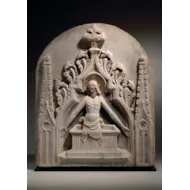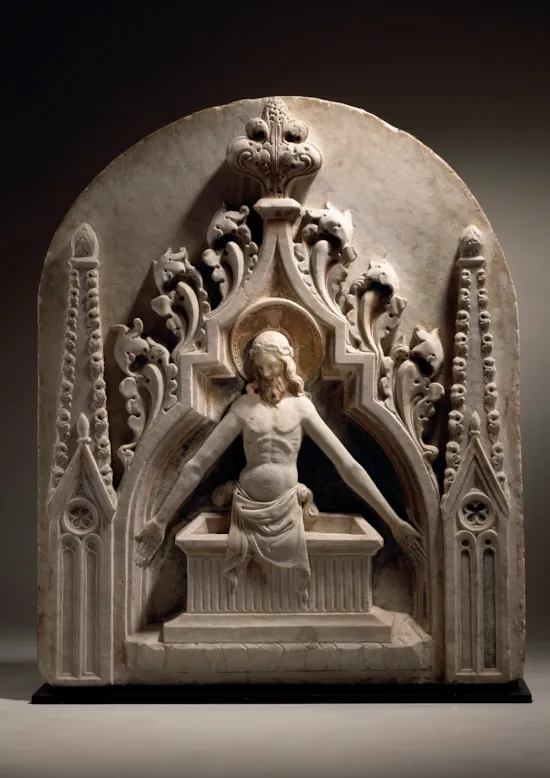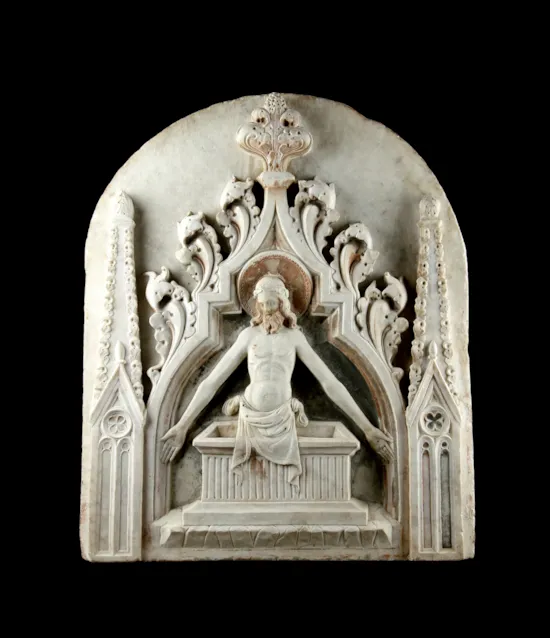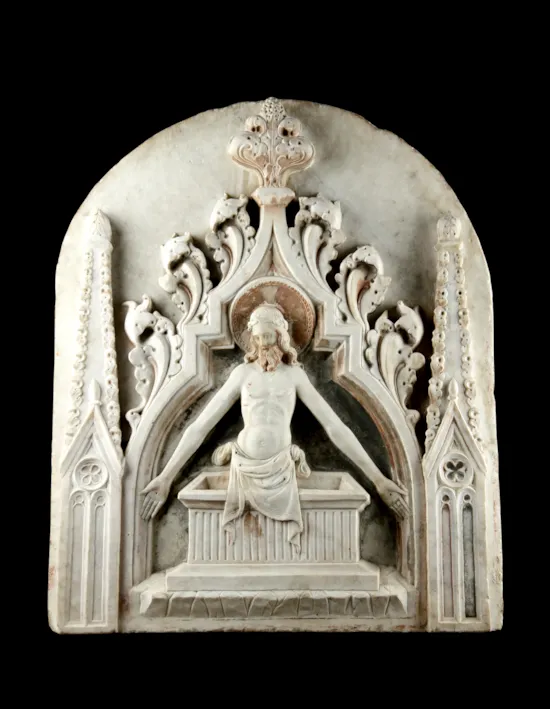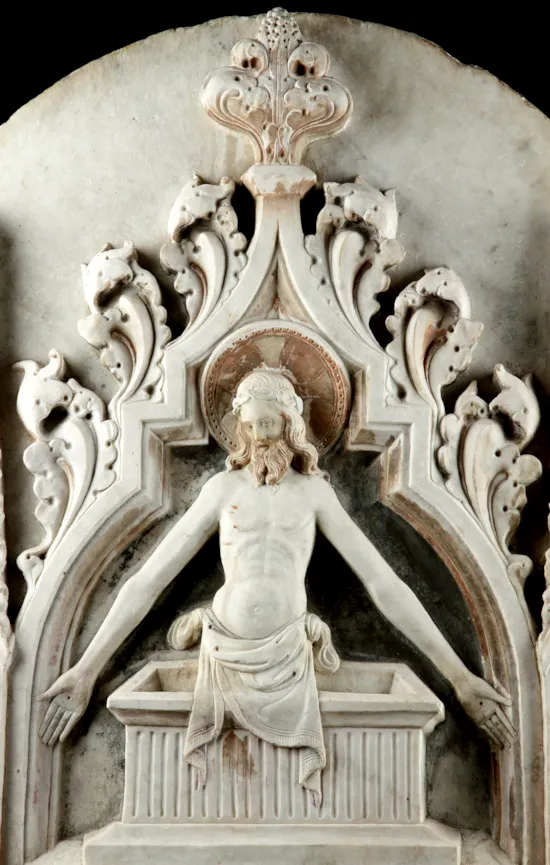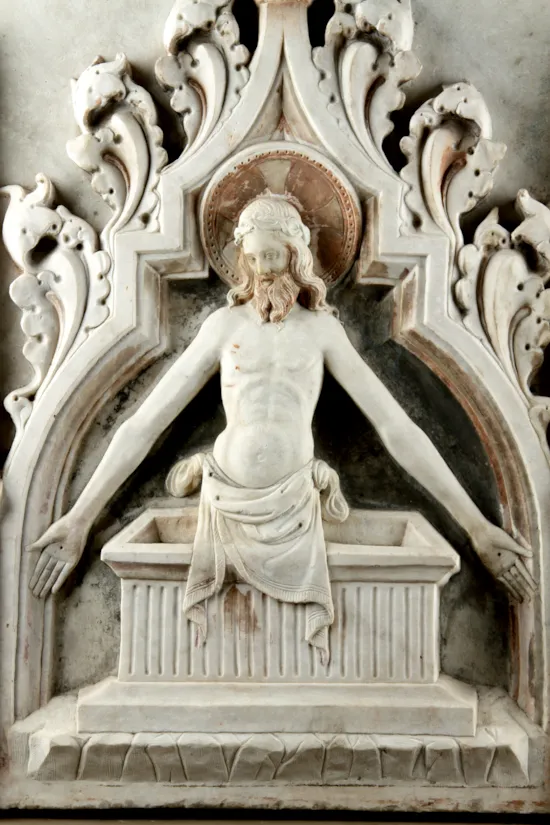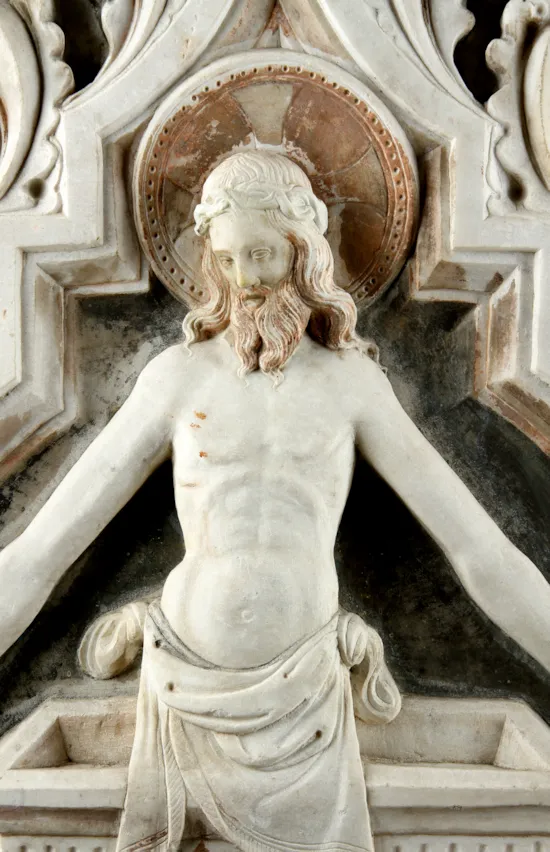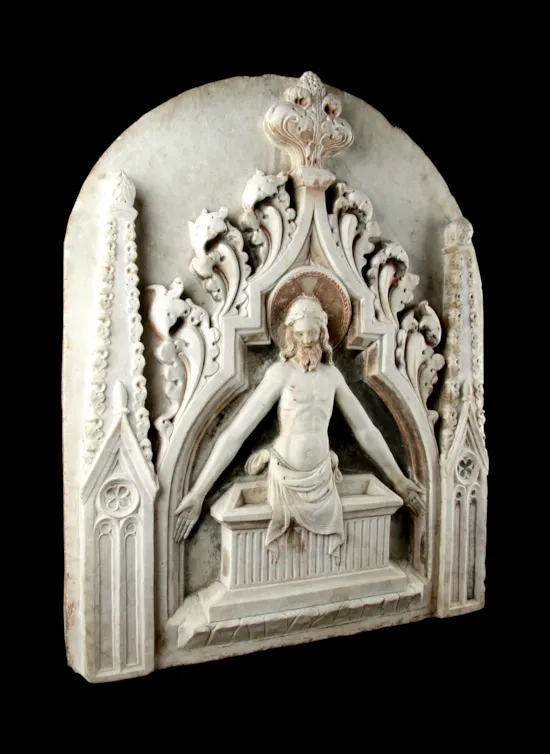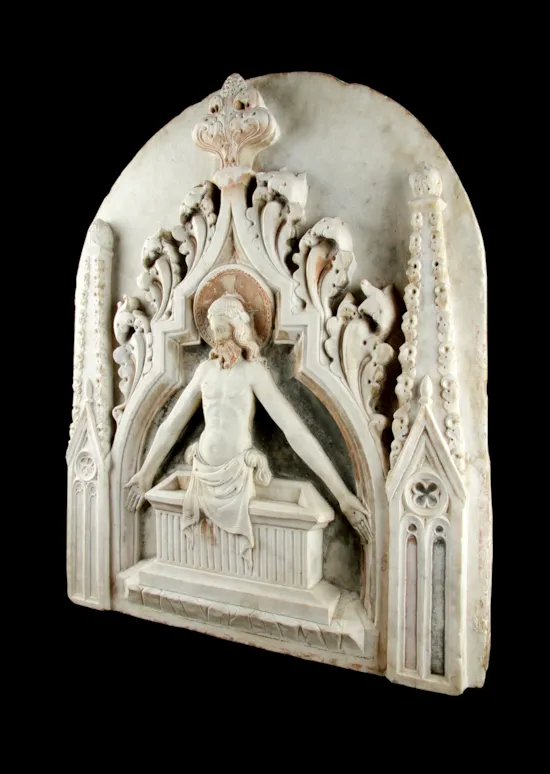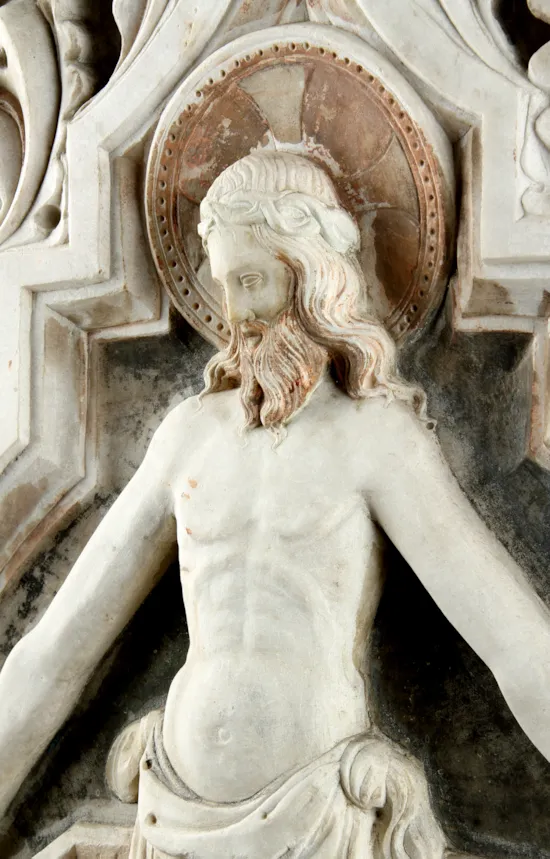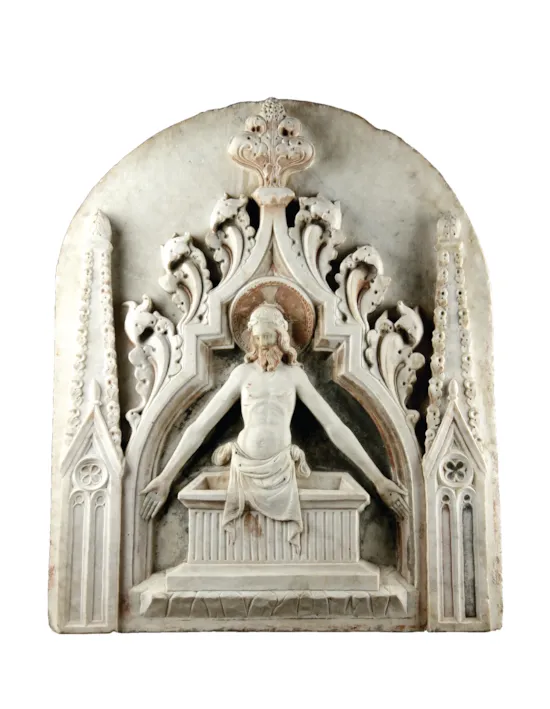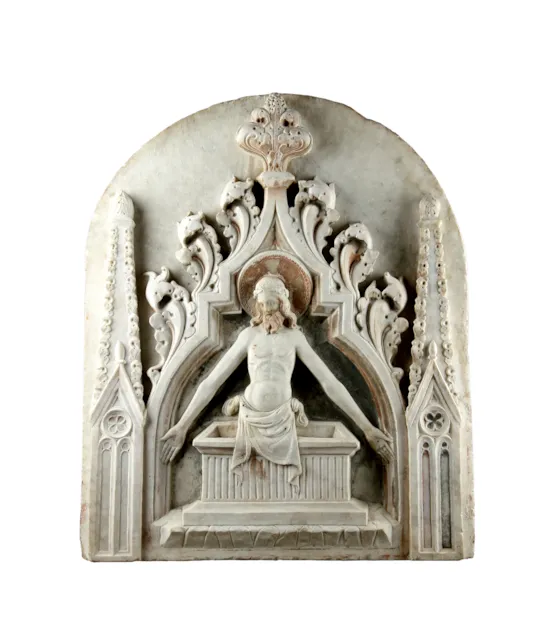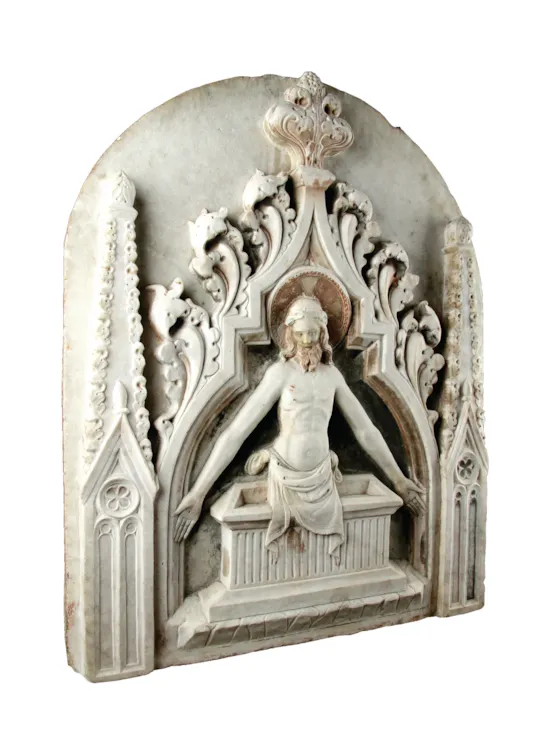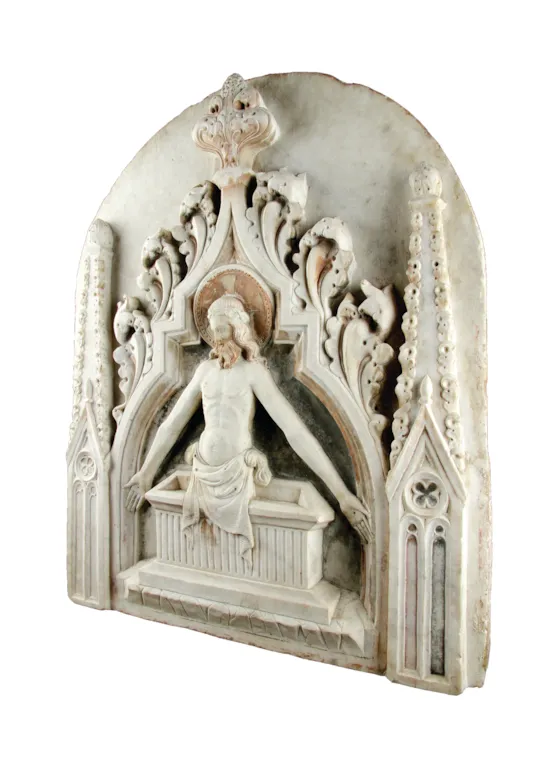Very Rare and Important Marble Relief of the ‘Resurrection of Christ’
A Very Rare and Important Marble Relief of the ‘Resurrection of Christ’
Attributed to the Master of the Mascoli Altar
Marble
Venice, Italy
Second half of the 15th Century
SIZE: 89cm high, 74cm wide, 14cm deep - 35 ins high, 29¼ ins wide, 5½ ins deep
Attributed to the Master of the Mascoli Altar
Marble
Venice, Italy
Second half of the 15th Century
SIZE: 89cm high, 74cm wide, 14cm deep - 35 ins high, 29¼ ins wide, 5½ ins deep
A Very Rare and Important Marble Relief of the ‘Resurrection of Christ’
Attributed to the Master of the Mascoli Altar
Marble
Venice, Italy
Second half of the 15th Century
SIZE: 89cm high, 74cm wide, 14cm deep - 35 ins high, 29¼ ins wide, 5½ ins deep
Attributed to the Master of the Mascoli Altar
Marble
Venice, Italy
Second half of the 15th Century
SIZE: 89cm high, 74cm wide, 14cm deep - 35 ins high, 29¼ ins wide, 5½ ins deep
LITERATURE:
Planiscig, L., ‘Die Bildhauer Venedigs in der ersten Hälfte des
Quattrocento’, Jahrbuch der kunsthistorischen Sammlungen in Wien, vol. 4 (1930),
pp. 47 - 120.
Poeschke, J., Die Skulptur des Mittelalters in Italien, Munich, 1998 - 2000
Pope-Hennessy, J., Italian Gothic Sculpture, London, 1955, 3/1985)
Tambini, A., ‘La chiesa della Croce Coperta di Lugo’, Stud. Romagn., vol. 48
(1997), pp. 47 - 63
This rare enchanting example of early fifteenth century Venetian sculpture depicts the resurrection of Christ from the tomb in a profoundly moving way, his arms shown wide open and his palms turned towards us exposing the stigmata and the wound in his chest. The slender acanthus leaves and the stepped
sharply outlined tabernacle framing the scene are strongly reminiscent of the
decorative elements present in the oeuvres of the sculptor referred to as the ‘Master of the Mascoli Altar’, a name derived from the marble altarpiece of the Virgin and Child with Saint Mark and James in the Mascoli Chapel of St. Mark’s Cathedral in Venice. Almost identical naturalistic foliage can be found in other altarpieces, such as the one signed by Andrea da Giona, now in the Metropolitan Museum of Art, New York or even the very similar though far less exquisitely executed altarpieces of Vescovato, presumed to be the work of the Genovese Gaggini’s. However, this relief with its elegant composition, its linear drapery, and the positioning of Christ together with the tomb in a forward plane, more convincingly matches the late international Gothic style of the Mascoli Altar.
Above the altar is an inscription dating the foundation of the chapel to 1430. Both the figures as well as the architectural frame of the altar were probably commissioned at that time. The relief of the Virgin and Child with Two Angels in the Corner Chapel of the Santa Maria dei Frari, Venice, is also commonly presumed to be by the same Master. Typical of both works is the tightly pulled drapery that reveals the lines of the body, accenting the pose and movement of the figures. The conventional Gothic frames were probably designed and executed by Venetian masons. There has been some debate about the style of the works attributed to the Mascoli Master. According to most scholars the master was a Venetian and he has been identified with a number of celebrated sculptors, in particular with Pierpaolo dalle Masegne, Giovanni Buon and Bartolomeo Buon. Others have argued the master was a Florentine on the basis of stylistic parallels, most notably with the works of Lorenzo Ghiberti. The Mascoli Master’s works in Venice influenced a number of artists in Venice during the 15th century, including for example Bartolomeo Buon.
Planiscig, L., ‘Die Bildhauer Venedigs in der ersten Hälfte des
Quattrocento’, Jahrbuch der kunsthistorischen Sammlungen in Wien, vol. 4 (1930),
pp. 47 - 120.
Poeschke, J., Die Skulptur des Mittelalters in Italien, Munich, 1998 - 2000
Pope-Hennessy, J., Italian Gothic Sculpture, London, 1955, 3/1985)
Tambini, A., ‘La chiesa della Croce Coperta di Lugo’, Stud. Romagn., vol. 48
(1997), pp. 47 - 63
This rare enchanting example of early fifteenth century Venetian sculpture depicts the resurrection of Christ from the tomb in a profoundly moving way, his arms shown wide open and his palms turned towards us exposing the stigmata and the wound in his chest. The slender acanthus leaves and the stepped
sharply outlined tabernacle framing the scene are strongly reminiscent of the
decorative elements present in the oeuvres of the sculptor referred to as the ‘Master of the Mascoli Altar’, a name derived from the marble altarpiece of the Virgin and Child with Saint Mark and James in the Mascoli Chapel of St. Mark’s Cathedral in Venice. Almost identical naturalistic foliage can be found in other altarpieces, such as the one signed by Andrea da Giona, now in the Metropolitan Museum of Art, New York or even the very similar though far less exquisitely executed altarpieces of Vescovato, presumed to be the work of the Genovese Gaggini’s. However, this relief with its elegant composition, its linear drapery, and the positioning of Christ together with the tomb in a forward plane, more convincingly matches the late international Gothic style of the Mascoli Altar.
Above the altar is an inscription dating the foundation of the chapel to 1430. Both the figures as well as the architectural frame of the altar were probably commissioned at that time. The relief of the Virgin and Child with Two Angels in the Corner Chapel of the Santa Maria dei Frari, Venice, is also commonly presumed to be by the same Master. Typical of both works is the tightly pulled drapery that reveals the lines of the body, accenting the pose and movement of the figures. The conventional Gothic frames were probably designed and executed by Venetian masons. There has been some debate about the style of the works attributed to the Mascoli Master. According to most scholars the master was a Venetian and he has been identified with a number of celebrated sculptors, in particular with Pierpaolo dalle Masegne, Giovanni Buon and Bartolomeo Buon. Others have argued the master was a Florentine on the basis of stylistic parallels, most notably with the works of Lorenzo Ghiberti. The Mascoli Master’s works in Venice influenced a number of artists in Venice during the 15th century, including for example Bartolomeo Buon.
Former French Private collection, gallery of Gustave Clément-Simon (1833 - 1909), in his Castle of Bach, Naves (Corrèze, France) since the late 19th century
Thence by descent until 2013
Ex Private collection
Thence by descent until 2013
Ex Private collection
Very Rare and Important Marble Relief of the ‘Resurrection of Christ’
